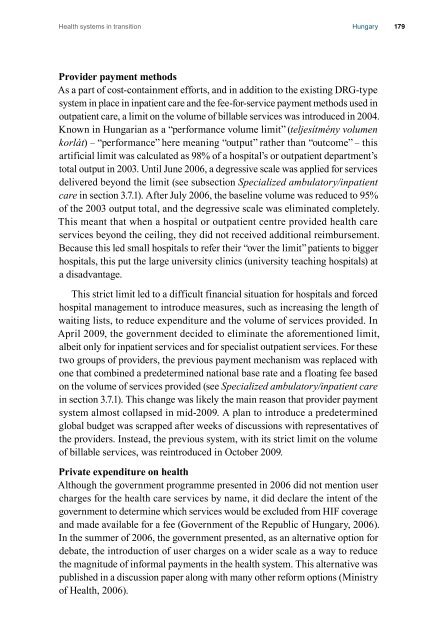Health Systems in Transition - Hungary - World Health Organization ...
Health Systems in Transition - Hungary - World Health Organization ...
Health Systems in Transition - Hungary - World Health Organization ...
Create successful ePaper yourself
Turn your PDF publications into a flip-book with our unique Google optimized e-Paper software.
<strong>Health</strong> systems <strong>in</strong> transition <strong>Hungary</strong> 179<br />
Provider payment methods<br />
As a part of cost-conta<strong>in</strong>ment efforts, and <strong>in</strong> addition to the exist<strong>in</strong>g DRG-type<br />
system <strong>in</strong> place <strong>in</strong> <strong>in</strong>patient care and the fee-for-service payment methods used <strong>in</strong><br />
outpatient care, a limit on the volume of billable services was <strong>in</strong>troduced <strong>in</strong> 2004.<br />
Known <strong>in</strong> Hungarian as a “performance volume limit” (teljesítmény volumen<br />
korlát) – “performance” here mean<strong>in</strong>g “output” rather than “outcome” – this<br />
artificial limit was calculated as 98% of a hospital’s or outpatient department’s<br />
total output <strong>in</strong> 2003. Until June 2006, a degressive scale was applied for services<br />
delivered beyond the limit (see subsection Specialized ambulatory/<strong>in</strong>patient<br />
care <strong>in</strong> section 3.7.1). After July 2006, the basel<strong>in</strong>e volume was reduced to 95%<br />
of the 2003 output total, and the degressive scale was elim<strong>in</strong>ated completely.<br />
This meant that when a hospital or outpatient centre provided health care<br />
services beyond the ceil<strong>in</strong>g, they did not received additional reimbursement.<br />
Because this led small hospitals to refer their “over the limit” patients to bigger<br />
hospitals, this put the large university cl<strong>in</strong>ics (university teach<strong>in</strong>g hospitals) at<br />
a disadvantage.<br />
This strict limit led to a difficult f<strong>in</strong>ancial situation for hospitals and forced<br />
hospital management to <strong>in</strong>troduce measures, such as <strong>in</strong>creas<strong>in</strong>g the length of<br />
wait<strong>in</strong>g lists, to reduce expenditure and the volume of services provided. In<br />
April 2009, the government decided to elim<strong>in</strong>ate the aforementioned limit,<br />
albeit only for <strong>in</strong>patient services and for specialist outpatient services. For these<br />
two groups of providers, the previous payment mechanism was replaced with<br />
one that comb<strong>in</strong>ed a predeterm<strong>in</strong>ed national base rate and a float<strong>in</strong>g fee based<br />
on the volume of services provided (see Specialized ambulatory/<strong>in</strong>patient care<br />
<strong>in</strong> section 3.7.1). This change was likely the ma<strong>in</strong> reason that provider payment<br />
system almost collapsed <strong>in</strong> mid-2009. A plan to <strong>in</strong>troduce a predeterm<strong>in</strong>ed<br />
global budget was scrapped after weeks of discussions with representatives of<br />
the providers. Instead, the previous system, with its strict limit on the volume<br />
of billable services, was re<strong>in</strong>troduced <strong>in</strong> October 2009.<br />
Private expenditure on health<br />
Although the government programme presented <strong>in</strong> 2006 did not mention user<br />
charges for the health care services by name, it did declare the <strong>in</strong>tent of the<br />
government to determ<strong>in</strong>e which services would be excluded from HIF coverage<br />
and made available for a fee (Government of the Republic of <strong>Hungary</strong>, 2006).<br />
In the summer of 2006, the government presented, as an alternative option for<br />
debate, the <strong>in</strong>troduction of user charges on a wider scale as a way to reduce<br />
the magnitude of <strong>in</strong>formal payments <strong>in</strong> the health system. This alternative was<br />
published <strong>in</strong> a discussion paper along with many other reform options (M<strong>in</strong>istry<br />
of <strong>Health</strong>, 2006).
















